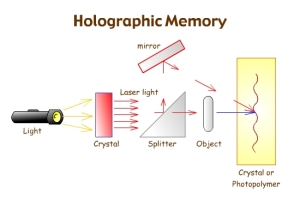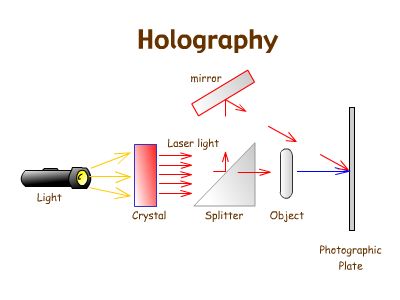Originally i was going to mention wavefunction only as an example of the information carried by particles within the System. I’m trying to stay away from controversial details and focus on the broader concepts that have a high degree of agreement. However, the more i read about quantum physics and wavefunction in particular, the more convinced i become that these properties represent the holographic memory in action.
I can’t see inside atoms or molecules. None of us can see a wavefunction. None of us can see an electromagnetic field, coherent or otherwise. Using all of our physical senses we can’t verify directly that these things really exist. We trust science to describe these concepts for us. This gives us something to pass around and discuss.
Science uses instruments and experiments to build their concepts, leaving the rest of us to put their theories to the test in real life. I’ve been working from the other direction. I started with real life and i’m looking for the scientific concepts that fit.
I have found the System of Life to be intelligent, responsive and capable of will, intent and even humor. My life’s path has taken me through many experiences considered impossible by scientific standards. I also read a lot, and have found many other folks who have lived the impossible life. I have tried to find the scientific concepts that could explain these experiences. After all, science is studying the same reality as the rest of us.
I have also studied much the body of literature produced by the outcasts of science, looking for the same kinds of clues. The System works! It is not done by unfathomable technology nor magic. The System functions using nothing but natural laws. What i am trying to do here is point out the natural processes identified by researchers that could produce the results i see. I’ve been guided by information furnished by the System itself, through agents and channels not recognized at all by science. I have tested my model repeatedly. I’ve held it up to the window of history and the patterns match. I have found this information processing model to fit.
On the other hand, i’m completely dependent on the description of others. Wavefunction is a case in point. I really don’t have any first hand experience with wave function or any other concept of quantum mechanics. I have to go by what i’ve read and what people tell me. I am excited about it because the descriptions of the properties of wavefunction coincide with the needs of the LifeOS model. It is like a piece of the puzzle slides effortlessly into place. Maybe it is too easy. Time will tell.
As an information processing system, the micro units need to have memory. The smallest particle needs the capacity to manage information.
“A wave function or wavefunction is a mathematical tool used in quantum mechanics to describe any physical system.
The values of the wave function are probability amplitudes — complex numbers — the squares of the absolute values of which, give the probability distribution that the system will be in any of the possible states.”
Quoted from: Wikipedia
In other words, the wave function is a way of describing the properties of a particle or group of particles. The wavefunction contains information about the physical object. Wavefunction is an imaginary model describing the reality of an object. The spin, momentum and other properties are as real as we can test experimentally.
Like the wiki says, wavefunction is a “tool” we can use to describe what seems to be going on. What ever is going on, it involves something big. Those “probability amplitudes” are huge numbers when used to describe very tiny particles. When combined with other particles, the number of possible states grows exponentially. In the model we are building here, this potential represents an infinite data storage capacity. In this model, the atom, with its structure and energized particles, is a single holographic memory unit. Its input is the dynamic flow of interference patterns laid down by the Holoverse. What it stores is the
comparison between current interference patterns generated by the system and past patterns. When they don’t match, a refraction of the mismatch is projected holographically throughout the system.
Binary Switches
In a binary computer system, it is the state of the binary switch that holds the data. The state of one switch tells you very little; it is only one bit. It takes eight bits to make one byte, the basic unit of information. It takes a lot of bits to make useful information.
If you could get inside the crystal structure that holds the switches in a modern computer, and try to measure the state of one of those transistors, you would most probably cause the state of the switch to change. The charges that hold those switches in their state are so tiny that just touching them could switch their state.
That is analogous to the problem encountered in quantum physics. When they try to measure the state of subatomic particles, the state changes. If matter is a memory medium, as the LifeOS model contends, then this odd behavior of subatomic particles is just as expected.
Infinite Memory States
If we look at matter as the holographic memory medium, then the state of particles is the very heart of the process. In this holographic memory system, it is the state of particles that holds the information. The state of one particle doesn’t tell us much, but the combined states of all the particles within a system projects its holographic image, which equals the current reality of that system.
In our binary computers, there are only two possible states for a unit of memory. In this system a unit of memory should have a nearly infinite number of states.
It would also seem that there would be several ways that those states could be manipulated to produce instant processing of information. This is like the register of a cpu, instead of centrally located, it functions at the quantum level. It is like the structure of a computer turned inside out. It is more like a computer network, where each unit does its own processing, while the combined processing of all the units acts as if it were all one process.
The state of the individual particle is set by the harmonic of the hologram it belongs to. The state can be changed by local input, but it remembers the state it should be in and registers the new state as an aberration. News of that mismatch spreads through the system holographically.
In this view, the fuzziness of matter detected by quantum mechanics is not because matter is unstable or imaginary, but because it is made up of a memory material capable of an infinite number of memory states.
When we are looking at matter at the quantum level it is like looking at the transistors in a computer. Studying one transistor will tell us that it has two states and that the state is controlled by a minute electrical current. That information tells us nothing about how that switch participates in the system, or what it contributes to the meaning of the data stored there.
When we study subatomic particles we are blinded to the macro by the same micro vision. We can’t see the computer for the transistors. Once we look at the Whole System as an information processor, then the uncertainties at the quantum level make perfect sense. Instead of a binary switch on which to base our data processor, we have particles that possess infinite memory states, grouped into atoms and molecules that organize those tiny bottomless pits for information into super-mega giant memory banks that also process their info on the fly. What these memory banks remember is where they have been and what they have done, while keeping track of what they are doing and where they are going. The Universe processes information on a cosmic scale. This is information, processing itself, in an endless loop. It isn’t only that the Universe operates by feedback loops, feedback might be considered its primary function.

